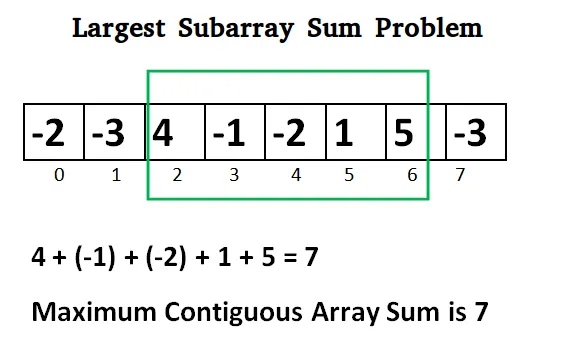Given an array arr[] of size **N, **the task is to find the maximum sum of a subsequence formed by concatenating disjoint subarrays whose lengths are prime numbers.
Examples:
Input:_ arr[] = {10, 10, 7, 10, 10, 10}_
Output:_ 50_
Explanation:
Subsequence with maximum sum is obtained by concatenating following two subarrays:
- {10, 10} of length 2, which is prime.
- {10, 10, 10} of length 3, which is prime.
The resulting subsequence is {10, 10, 10, 10, 10}.
Sum of the subsequence is 50.
Input:_ arr[] = {11, 8, 12}_
Output:_ 31_
Naive Approach: The simplest approach is to use recursion to calculate the value of the maximum sum of subsequence. In each step, call multiple recursive calls for each of the prime numbers smaller than N. The recurrence relation is given by:
sum(N) = (arr[N] + arr[N – 1] + … arr[N – P + 1]) + sum(N – P – 1)
where,
P is the prime length of the subarray chosen,
sum(N) is the function that finds the maximum sum of resulting subsequence.
The above recurrence relation is for only one Prime Number. Therefore, there can be more than one possible subsequence can be formed by selecting different subarrays of different prime length. Below is the resulting recurrence relation formed:
sum(N) = max(sum(aN, …, aN-P1+1) + sum(N – P1 – 1), sum(aN, …, aN-P2+1) + sum(N – P2 – 1), …, sum(aN, …, aN-Pk+1) + sum(N – Pk – 1))
where,
P1, P2, … Pk are prime numbers smaller than N.
Time Complexity:_ O(KN) where K is the number of _the _prime numbers smaller than N. Approximately K = (N / LogN) _
Auxiliary Space: O(1)
Dynamic Programming **using Bottom-up Approach: **The recursive calls in the above can also be reduced using an auxiliary array dp[] and calculate the value of each state in the bottom-up approach. Below are the steps:
- Create an auxiliary array prime[] to store all the prime numbers smaller or equal to N.
- Maintain the Sieve of Eratosthenes and traverse it to populate the values of array prime[].
- Create an auxiliary array** dp[] **of size N.
- Initialize the state 0 and 1 as dp[0] = 0 and dp[1] = 0.
- Traverse the array dp[] over the range** [2, N]** and update each state as:
_ MSS(i) = max[sum(ai…ai-P1+1) + sum(i-P1-1), sum(ai…ai-P2+1) + sum(i-P2-1), … sum(ai…ai-Pk+1) + sum(i-Pk-1) ] for all prime numbers P1, P2, … Pk smaller than N._
- Initialize pref[] array to store prefix sum to calculate sum(l, …, r) efficiently.
ai + ai+1 + … aj = sum(i … j) = pref[j] – pref[i – 1]
- Print the value of dp[N] after the above steps as the result.
Below is the implementation of the above approach:
- C++
// C++ program for the above approach
#include <bits/stdc++.h>
**using** **namespace** std;
#define MAX 100005
// Function to return all prime numbers
// smaller than N
vector<``**int**``> SieveOfEratosthenes()
{
// Create a boolean array "prime[0..n]"
**bool** seive[MAX];
// Initialize all its entries as true
**memset**``(seive, **true**``, **sizeof**``(seive));
**for** (``**int** p = 2; p * p < MAX; p++) {
// If prime[p] is not changed,
// then it is a prime
**if** (seive[p] == **true**``) {
// Update all multiples of
// p greater than or equal
// to the square of it
**for** (``**int** i = p * p;
i < MAX; i += p) {
seive[i] = **false**``;
}
}
}
// Stores all prime numbers
// smaller than MAX
vector<``**int**``> v;
// Store all prime numbers
**for** (``**int** p = 2; p < MAX; p++) {
// If p is prime
**if** (seive[p]) {
v.push_back(p);
}
}
**return** v;
}
// Function to build the auxiliary DP
// array from the start
**void** build(``**int** dp[], **int** arr[], **int** N)
{
// Base Case
dp[0] = 0;
dp[1] = 0;
// Stores all prime numbers < N
vector<``**int**``> prime
= SieveOfEratosthenes();
// Stores prefix sum
**int** pref[N + 1];
pref[0] = 0;
// Update prefix sum
**for** (``**int** i = 1; i <= N; i++) {
pref[i] = pref[i - 1]
+ arr[i - 1];
}
// Iterate over range
**for** (``**int** i = 2; i <= N; i++) {
// Update each state i.e.. when
// current element is excluded
dp[i] = dp[i - 1];
**for** (``**int** j = 0;
j <= prime.size(); j++) {
// Find start & end index
// of subarrays when prime[i]
// is taken
**int** r = i - 1;
**int** l = r - prime[j] + 1;
// Check if starting point
// lies in the array
**if** (l < 0)
**break**``;
**int** temp = 0;
// Include the elements
// al al+1 ... ar
temp = pref[r + 1] - pref[l];
// Check if element lies before
// start of selected subarray
**if** (l - 2 >= 0)
temp += dp[l - 2 + 1];
// Update value of dp[i]
dp[i] = max(dp[i], temp);
}
}
}
// Function to find the maximum sum
// subsequence with prime length
**void** maxSumSubseq(``**int** arr[], **int** N)
{
// Auxiliary DP array
**int** dp[N + 1];
// Build DP array
build(dp, arr, N);
// Print the result
cout << dp[N];
}
// Driver Code
**int** main()
{
// Given arr[]
**int** arr[] = { 10, 10, 7, 10, 10, 10 };
// Size of array
**int** N = **sizeof**``(arr) / **sizeof**``(arr[0]);
// Function Call
maxSumSubseq(arr, N);
**return** 0;
}
Output:
50
Time Complexity:_ O(N * K)_
Auxiliary Space:_ O(N)_
Attention reader! Don’t stop learning now. Get hold of all the important DSA concepts with the DSA Self Paced Course at a student-friendly price and become industry ready.
#arrays #dynamic programming #recursion #prefix-sum #prime number #sieve #subarray #subsequence
